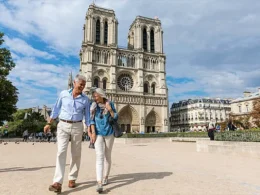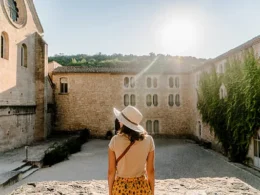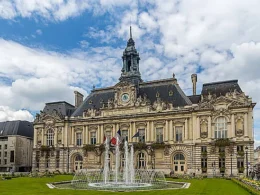The architectural wonders of French historic cities stand as testaments to the rich cultural and artistic heritage of the country. From the iconic cathedrals of Paris to the Renaissance splendor of Lyon, and the timbered houses of Strasbourg, each city boasts a unique blend of architectural styles that reflect its historical significance.
Bordeaux, with its neoclassical grandeur and historic porticoes, further adds to the diverse architectural landscape of France. These cities serve as living museums, offering a glimpse into the craftsmanship and artistry of bygone eras.
Exploring the architectural marvels of French historic cities provides an enriching experience for enthusiasts and scholars alike, unraveling the layers of history and culture woven into the very fabric of these cities.
Paris: City of Iconic Cathedrals
In the rich architectural landscape of Paris, iconic cathedrals have stood for centuries as testaments to the city’s enduring history and cultural significance. These iconic landmarks, including the Notre-Dame Cathedral and the Basilique du Sacré-Cœur, hold immense historical significance and exemplify the magnificence of Gothic architecture.
The Notre-Dame Cathedral, with its stunning rose windows and flying buttresses, is a prime example of French Gothic architecture and has played a pivotal role in shaping the cultural heritage of Paris. Similarly, the Basilique du Sacré-Cœur, perched atop the Montmartre hill, not only showcases breathtaking architectural grandeur but also serves as a symbol of cultural and religious significance.
These cathedrals not only draw millions of visitors annually but also stand as enduring testaments to Paris’s rich historical and cultural legacy.
Lyon: Renaissance Splendor and Silk Heritage
Continuing from the previous exploration of Paris’s iconic cathedrals, Lyon’s architectural landscape showcases Renaissance splendor and is steeped in a rich heritage of silk production.
Lyon’s Renaissance architecture is exemplified by the Vieux Lyon (Old Lyon) district, a UNESCO World Heritage site. The district features elegant townhouses, courtyards, and traboules (hidden passageways) that reflect the city’s prosperous Renaissance era.
Lyon’s silk heritage dates back to the 16th century when the city became a major center for silk production and trade. The historic silk industry is celebrated at the Maison des Canuts, a museum dedicated to the art of silk-weaving.
Today, Lyon continues to be renowned for its silk industry, with the Presqu’île district housing luxury silk shops and ateliers, preserving the city’s rich silk heritage.
Strasbourg: Timbered Houses and Gothic Cathedral
Strasbourg’s architectural landscape boasts picturesque timbered houses and a magnificent Gothic cathedral, seamlessly blending the Renaissance splendor and silk heritage previously explored in Lyon with its own distinct character.
Notably, the city’s historic center showcases a wealth of timber-framed buildings, offering a striking contrast to the soaring spires and intricate details of the iconic Cathedral of Our Lady. The timbered houses exude a medieval charm, with their crooked, half-timbered facades adding to the city’s allure.
Meanwhile, the Cathedral of Our Lady, with its awe-inspiring gothic architecture, stands as an architectural marvel, drawing visitors from around the world. The intricate carvings and imposing height of the cathedral make it a focal point of Strasbourg’s skyline, further enhancing the city’s reputation as a treasure trove of architectural wonders.
Bordeaux: Neoclassical Grandeur and Historic Porticoes
Bordeaux’s architectural landscape showcases neoclassical grandeur and historic porticoes, adding to the rich tapestry of France’s historic cities. The city’s neoclassical architecture reflects a time of revival in the classical forms and designs, with prominent buildings such as the Grand Théâtre exuding this style.
Portico design is a defining feature of many of Bordeaux’s historic buildings, with elaborate colonnades and grand entrances creating an imposing yet elegant aesthetic. The historic waterfront along the Garonne River provides a picturesque backdrop to the city’s architectural wonders, blending the beauty of the neoclassical structures with the charm of the waterfront.
Urban planning in Bordeaux has been instrumental in preserving and showcasing these architectural marvels, ensuring that the city’s neoclassical grandeur and historic porticoes continue to captivate visitors from around the world.
Frequently Asked Questions
What Are the Best Times of Day to Visit These Iconic Cathedrals and Historic Sites in These French Cities to Avoid Crowds?
To avoid crowds and fully appreciate the iconic cathedrals and historic sites in French cities, plan your visit during early morning or late afternoon. These times offer a quieter atmosphere and optimal lighting for experiencing these architectural wonders.
Are There Any Lesser-Known Architectural Gems or Hidden Landmarks in These Cities That Are Worth Visiting?
When exploring architectural wonders, it’s essential to seek out hidden gems and offbeat landmarks. Discovering lesser-known sites provides a unique perspective and deeper understanding of the local culture and history.
How Have These Historic Cities Adapted Their Architectural Heritage to Modern Urban Life and Development?
Adaptive architecture and urban development in historic French cities have harmonized historic preservation with modernization. The integration of contemporary infrastructure and amenities while respecting architectural heritage is a testament to these cities’ ability to evolve without compromising their cultural legacy.
Can Visitors Access the Rooftops or Towers of These Cathedrals and Historic Buildings for a Unique Perspective of the City?
Accessing rooftops and towers of cathedrals and historic buildings in French cities offers unparalleled aerial views, revealing hidden landmarks and architectural gems. This unique perspective allows visitors to immerse themselves in local folklore and appreciate the historic adaptation amidst urban development.
What Are Some Local Legends or Folklore Surrounding the Construction and History of These Architectural Wonders in These French Cities?
Local legends and folklore surrounding the construction and history of architectural wonders in French cities offer a unique perspective on the hidden landmarks. These stories add depth to the understanding of the cultural and historical significance of these structures.










